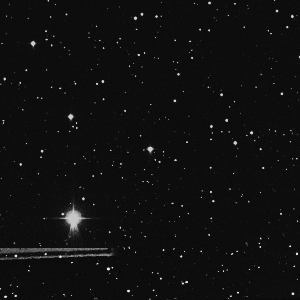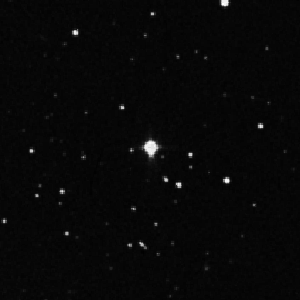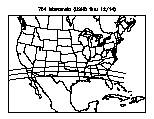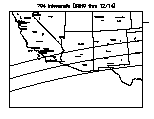Asteroid (704) Interamnia will occult a 10th magnitude star in the early morning hours of 1996 Dec 17, as discovered by Edwin Goffin and reported by David Dunham. The event should be visible in Southern California, Central Arizona and New Mexico, eastward across the southern US. The asteroid should be at about V=10.3 (V-R=0.36), the star is V=10.1, B-V=1.1, V-R=0.6. The flux drop should be about 55% in V or 45% in B. For an assumed diameter of 334 km, a central chord would last 29.8 seconds. This prediction is based on USNOFS transit telescope measurements, 11 positions of the star and 21 measurements of the asteroid. The uncertainty on the prediction is 0.049 arcsec in right ascension and 0.070 arcsec in declination. The quality of the astrometry plus the large size for the asteroid make this prediction very solid. The uncertainty on the track location is roughly 1/4 of a diameter.
At the time of the event, Interamnia will be 40 degrees above the horizon as seen from Flagstaff. The moon will not be a factor as it will have set already. The event should be easily seen in the western USA and will be progressively closer to the horizon further to the east. The catalog coordinate of the star is ra=03:24:07.468, dec=+33:36:17.89, J2000. There will be additional transit telescope measurements made between now and the time of the event and the new measurments will be added to the prediction as time allows.
 The field around the star is shown from this extraction from the Digital
Sky Survey. The wide field image shows an 18 arc-minute square field centered
on the occultation star. There is also a 5th magnitude star in this field.
North is up and east is to the left in this image.
The field around the star is shown from this extraction from the Digital
Sky Survey. The wide field image shows an 18 arc-minute square field centered
on the occultation star. There is also a 5th magnitude star in this field.
North is up and east is to the left in this image.
 This is a 6 arc-minute field around the occultation star.
This is a 6 arc-minute field around the occultation star.
The prediction team consists of Ron Stone at the US Naval Observatory providing transit measurements, Larry Wasserman at Lowell Observatory is processing the measurements and generating the predictions and plots, and Marc Buie, also Lowell Obs., is coordinating the collection and dissemination of information (like this WWW page). Direct comments and questions to lhw@lowell.edu.

